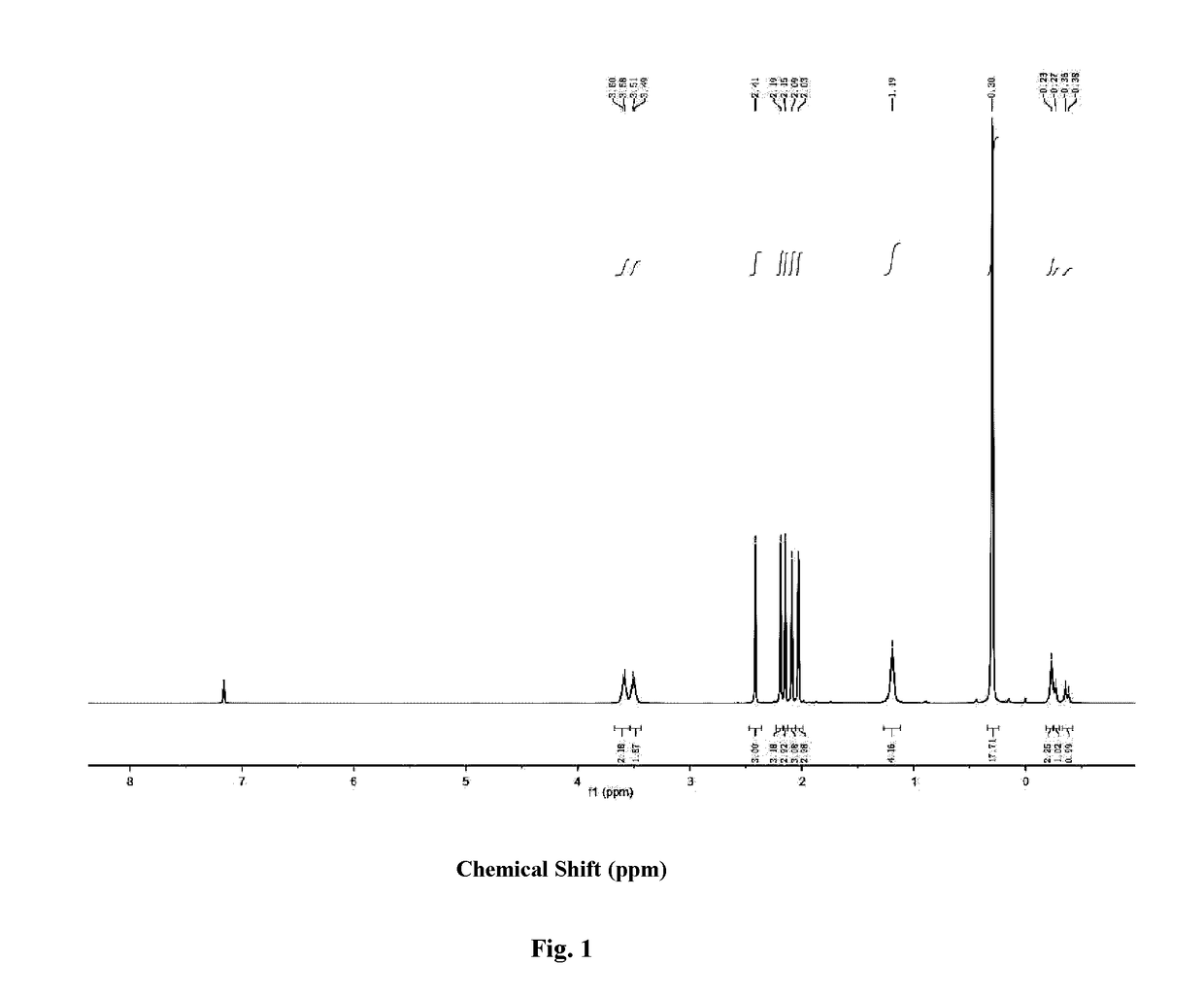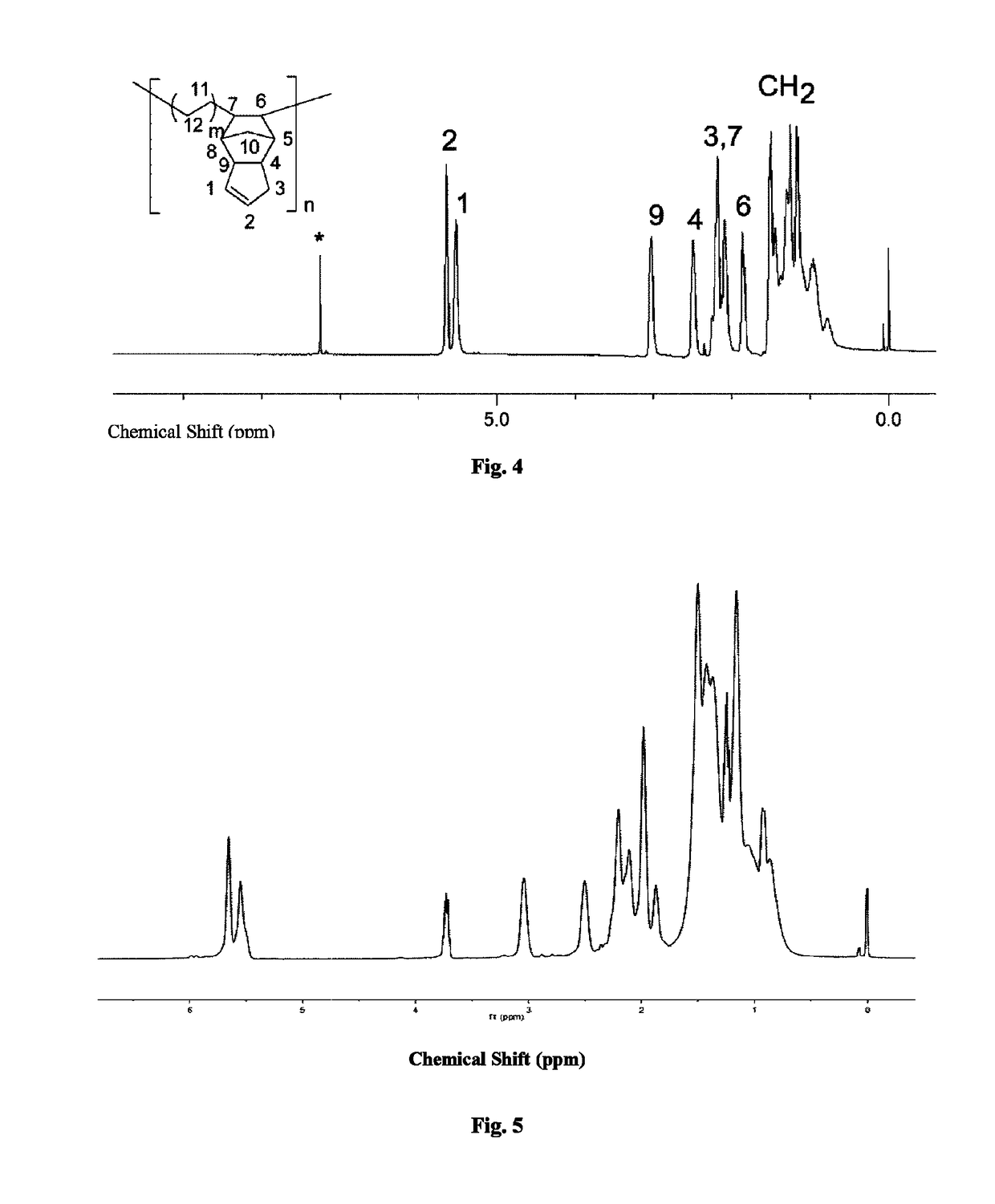Metallocene complex, preparation method thereof and catalyst composition
a technology of metalocene complex and catalyst, which is applied in the field of catalysts, can solve the problems of unreported mono-metallocene complex without side chains having a larger opening space, and achieve the effects of strong electron-donating capacity, high catalytic activity of more sterically hindered monomers, and high comonomer incorporation
- Summary
- Abstract
- Description
- Claims
- Application Information
AI Technical Summary
Benefits of technology
Problems solved by technology
Method used
Image
Examples
example 1
[0105]Under the protective condition of nitrogen gas, 0.3 g (1.56 mmol) of a thiophene-fused cyclopentadienyl ligand 1 was dissolved in 8 ml of n-hexane and was dropped to a n-hexane solution containing 0.7 g (1.56 mmol) of Sc(CH2SiMe3)3(thf)2, a reaction was performed for 12 h, the reaction solution was concentrated, and recrystallization was performed to obtain 0.57 g of a light yellow thiophene-fused metallocene type scandium alkyl complex (I-1) with a molecular formula of C22H41OSScSi2, wherein the yield was 75% and the reaction formula was as follows:
[0106]
[0107]The metallocene type scandium alkyl complex (I-1) obtained in Example 1 was analyzed using elemental analysis to obtain a result of elemental analysis (%): C, 58.52; H, 8.85.
example 2
[0108]The steps were the same as those in Example 1 except that ligand 1 in Example 1 was replaced by ligand 2 such that a thiophene-fused metallocene type scandium alkyl complex (I-2) with a molecular formula of C24H45OSScSi2 was obtained, and the reaction formula was as follows:
[0109]
[0110]The metallocene type scandium alkyl complex (I-2) obtained in Example 2 was analyzed using nuclear magnetic resonance to obtain a hydrogen nuclear magnetic resonance spectrogram thereof as shown in FIG. 1. The result of nuclear magnetic resonance is:
[0111]1H NMR(C6D6, 25° C.): δ 3.59 (br s, 2H, THF), 3.50 (br s, 2H, THF), 2.41 (s, 3H), 2.19 (s, 3H), 2.15 (s, 6H), 2.09 (s, 1H), 1.19 (br s, 4H), 0.30 (s, 18H, CH2SiMe3), −0.23 (br s, 2H, CH2SiMe3), −0.28 (d, J=0.08 Hz, 1H, CH2SiMe3), −0.37 (d, J=0.08 Hz, 1H, CH2SiMe3) ppm.
[0112]13CNMR(C6D6, 25° C.): δ 133.31, 130.43, 126.24, 124.77, 121.80, 110.18, 109.12, 71.54, 24.96, 24.77, 13.87, 13.30, 13.03, 12.68, 12.64, 12.28, 4.34 ppm.
[0113]The metallocene...
example 3
[0114]The steps were the same as those in Example 1 except that ligand 1 in Example 1 was replaced by ligand 3 such that a thiophene-fused metallocene type scandium alkyl complex (I-3) with a molecular formula of C23H43OSScSi2 was obtained, and the reaction formula was as follows:
[0115]
[0116]The metallocene type scandium alkyl complex (I-3) obtained in Example 3 was analyzed using nuclear magnetic resonance to obtain a hydrogen nuclear magnetic resonance spectrogram thereof as shown in FIG. 2. The result of nuclear magnetic resonance is:
[0117]1H NMR(C6D6, 25° C.): δ 6.32 (s, 1H), 3.59 (br s, 4H), 2.29 (s, 3H), 2.17 (s, 3H), 2.16 (s, 6H), 1.18 (br s, 4H), 0.29 (s, 18H), −0.20 (s, 4H) ppm.
[0118]13CNMR(C6D6, 25° C.): δ 138.15, 132.56, 125.94, 123.86, 116.28, 109.77, 109.18, 71.46, 25.34, 24.94, 16.54, 16.20, 13.39, 13.12, 12.51, 4.41 ppm.
[0119]The metallocene type scandium alkyl complex (I-3) obtained in Example 3 was analyzed using elemental analysis to obtain a result of elemental an...
PUM
| Property | Measurement | Unit |
|---|---|---|
| atomic number | aaaaa | aaaaa |
| atomic number | aaaaa | aaaaa |
| reaction time | aaaaa | aaaaa |
Abstract
Description
Claims
Application Information
 Login to View More
Login to View More - R&D
- Intellectual Property
- Life Sciences
- Materials
- Tech Scout
- Unparalleled Data Quality
- Higher Quality Content
- 60% Fewer Hallucinations
Browse by: Latest US Patents, China's latest patents, Technical Efficacy Thesaurus, Application Domain, Technology Topic, Popular Technical Reports.
© 2025 PatSnap. All rights reserved.Legal|Privacy policy|Modern Slavery Act Transparency Statement|Sitemap|About US| Contact US: help@patsnap.com



